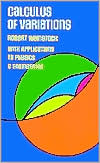

 |

|

Sold Out
Book Categories |
Preface Chapter 1. Introduction Chapter 2. Background Preliminaries
1. Piecewise continuity, piecewise differentiability 2. Partial and total differentiation 3. Differentiation of an integral 4. Integration by parts 5. Euler's theorem on homogeneous functions
6. Method of undetermined lagrange multipliers 7. The line integral 8. Determinants 9. Formula for surface area 10. Taylor's theorem for functions of several variables
11. The surface integral 12. Gradient, laplacian 13. Green's theorem (two dimensions) 14. Green's theorem (three dimensions)
Chapter 3. Introductory Problems
1. A basic lemma 2. Statement and formulation of several problems 3. The Euler-Lagrange equation 4. First integrals of the Euler-Lagrange equation. A degenerate case 5. Geodesics
6. The brachistochrone 7. Minimum surface of revolution 8. Several dependent variables 9. Parametric representation
10. Undetermined end points 11. Brachistochrone from a given curve to a fixed point Chapter 4. Isoperimetric Problems
1. The simple isoperimetric problem 2. Direct extensions 3. Problem of the maximum enclosed area 4. Shape of a hanging rope. 5. Restrictions imposed through finite or differential equations Chapter 5. Geometrical Optics: Fermat's Principle
1. Law of refraction (Snell's law) 2. Fermat's principle and the calculus of variations Chapter 6. Dynamics of Particles
1. Potential and kinetic energies. 2. Generalized coordinates 3. Hamilton's principle. Lagrange equations of motion 3. Generalized momenta. Hamilton equations of motion.
4. Canonical transformations 5. The Hamilton-Jacobi differential equation 6. Principle of least action 7. The extended Hamilton's principle Chapter 7. Two Independent Variables: The Vibrating String
1. Extremization of a double integral 2. The vibrating string 3. Eigenvalue-eigenfunction problem for the vibrating string
4. Eigenfunction expansion of arbitrary functions. Minimum characterization of the eigenvalue-eigenfunction problem 5. General solution of the vibrating-string equation
6. Approximation of the vibrating-string eigenvalues and eigenfunctions (Ritz method) 7. Remarks on the distinction between imposed and free end-point conditions Chapter 8. The Sturm-Liouville Eigenvalue-Eigenfunction Problem
1. Isoperimetric problem leading to a Sturm-Liouville system 2. Transformation of a Sturm-Liouville system 3. Two singular cases: Laguerre polynomials, Bessel functions Chapter 9. Several Independent Variables: The Vibrating Membrane
1. Extremization of a multiple integral 2. Change of independent variables. Transformation of the laplacian 3. The vibrating membrane 4. Eigenvalue-eigenfunction problem for the membrane
5. Membrane with boundary held elastically. The free membrane 6. Orthogonality of the eigenfunctions. Expansion of arbitrary functions 7. General solution of the membrane equation
8. The rectangular membrane of uniform density 9. The minimum characterization of the membrane eigenvalues 10. Consequences of the minimum characterization of the membrane eigenvalues
11. The maximum-minimum characterization of the membrane eigenvalues 12. The asymptotic distribution of the membrane eigenvalues 13. Approximation of the membrane eigenvalues Chapter 10. Theory of Elasticity
1. Stress and strain 2. General equations of motion and equilibrium 3. General aspects of the approach to certain dynamical problems 4. Bending of a cylindrical bar by couples
5. Transverse vibrations of a bar 6. The eigenvalue-eigenfunction problem for the vibrating bar 7. Bending of a rectangular plate by couples 8. Transverse vibrations of a thin plate
9. The eigenvalue-eigenfunction problem for the vibrating plate 10. The rectangular plate. Ritz method of approximation Chapter 11. Quantum Mechanics
1. First derivation of the Schrödinger equation for a single particle 2. The wave character of a particle. Second derivation of the Schrödinger equation
3. The hydrogen atom. Physical interpretation of the Schrödinger wave functions 4. Extension to systems of particles. Minimum character of the energy eigenvalues
5. Ritz method: Ground state of the helium atom. Hartree model of the many-electron atom Chapter 12. Electrostatics
1. Laplace's equation. Capacity of a condenser 2. Approximation of the capacity from below (relaxed boundary conditions) 3. Remarks on problems in two dimensions
4. The existence of minima of the Dirichlet integral
Bibliography; Index
Login|Complaints|Blog|Games|Digital Media|Souls|Obituary|Contact Us|FAQ
CAN'T FIND WHAT YOU'RE LOOKING FOR? CLICK HERE!!! X
 You must be logged in to add to WishlistX
 This item is in your Wish ListX
 This item is in your CollectionCalculus of Variations: With Applications to Physics and Engineering
X
 This Item is in Your InventoryCalculus of Variations: With Applications to Physics and Engineering
X
 You must be logged in to review the productsX
 X
 X

Add Calculus of Variations: With Applications to Physics and Engineering, This text is basically divided into two parts. Chapters 1–4 include background material, basic theorems and isoperimetric problems. Chapters 5–12 are devoted to applications, geometrical optics, particle dynamics, the theory of elasticity, electrostatics,, Calculus of Variations: With Applications to Physics and Engineering to the inventory that you are selling on WonderClubX
 X

Add Calculus of Variations: With Applications to Physics and Engineering, This text is basically divided into two parts. Chapters 1–4 include background material, basic theorems and isoperimetric problems. Chapters 5–12 are devoted to applications, geometrical optics, particle dynamics, the theory of elasticity, electrostatics,, Calculus of Variations: With Applications to Physics and Engineering to your collection on WonderClub |